日本动漫:神道及人性【英文】
英文版日本人文介绍
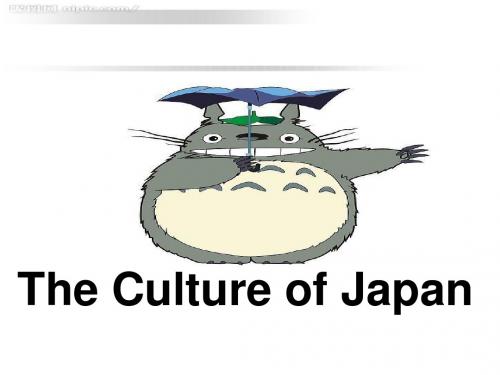
Eating a Meal Before eating, Japanese people say "itadakimasu," a polite phrase meaning "I receive this food." This expresses thanks to whoever worked to prepare the food in the meal. After eating, people once again express their thanks for the meal by saying "gochiso sama deshita," which literally means "it was quite a feast."
The word Geisha is derived from “Gei”, which in Japanese performance or entertainer, and “sha”, which means “person”, and dates back 400 years ago to the Edo period(江户 时代). During this period the Geisha entertained at banquets and social gatherings by playing Shamise(日本三弦琴), singing, and giving dance performances.
3Buckwheat ['bʌkwi:t] noodles荞麦 面条
• Buckwheat noodles or soba is also a typical Japanese dish. There are some people that eat soba at least once a day. Many office workers make it a habit to have soba for lunch. Soba noodles are a mixture of buckwheat, flour ['flauə] 面粉and eggs. It looks similar to spaghetti in shape. It is first boiled, and then dipped in a soup made of soy sauce, salt, sweet sake, and bonito[bə'ni:təu] shavings when it is being eaten. Because soba is long, it is considered a symbol of long life.
日本神道

从1895年日本侵占台湾,1931年“ 九· 一八”事变占领我国东北,翌年进攻上海等侵 略行径都作为“追慕”的“光荣史迹”而雕在那 里。在神社一侧的陈列馆里,陈列着当年侵华日 军的武器、战利品、遗物、遗书和照片。神社大 殿里供奉着日本明治维新以来历次对外战争中2 46万多名战死者的牌位,其中大多是死于对外 侵略战争的军人和战犯。1978年10月,东 条英机等14名甲级战犯和两千余名乙级、丙级 战犯的牌位也被移进这个神社。
伏见稻荷神社
吉备津神社
日本神道在动漫中的运用
靖国神社 (Yasukuni Shrine) 是日本近代 史上军国主义的精神支柱。它建于1869 年(明治维新第二年),最初叫“东京招魂 社”,1879年改称为“靖国神社”。它 把在明治维新以来历次战争中死去的亡灵作 为神来祭祀。靖国神社坐落在日本东京九段 北,占地10万多平方米。神社大门外两侧 各竖一座高约十米的石塔。石塔建于193 5年,塔身上有16块浮雕,反映的都是为 日本侵华战争树碑立传的内容。
神社的参拜程序
1、打从穿过鸟居开始就是神的领域 神社在参道入口处配建“鸟居”(牌坊), 举步踏入鸟居,便意味着辞离凡界进入神域。 所以,参拜者进出鸟居时,都须轻轻致礼。
2、参道不只是给人走,神也要走。
穿过第一个鸟居开始,一直延伸到神社本殿的道 路,日本称作参道。日本人大多走到参道的两旁 ,极少走到参道中央,因为中间是留给神走的。 想到神社求个符什么的人就得牢牢记住了,就算 你不虔诚也得作作样子,要不然买的御守不灵, 只是个装饰品。
朴素的古神道
神佛融合的两部神道
“本地垂迹”中的山王神道
根叶花果混映的吉田神道
反“本地垂迹”的伊势神道
儒学神道的先驱吉川神道
日,本,动漫中英文对照表

Sakura diaries(H) 樱通信 01-04
Samuari X 神剑闯江湖英文版
Samurai Champloo 琉球狂侍
Samurai Crusader
Samurai Deepeder KYO 鬼眼狂刀
Shadow Skill 影技 01-26 OVA
Shaman King/Hiryuki Takei/shamanking 通灵王/通灵童子 01-64
Platonic chain 帕拉图之链
Please Open the Door 打开时空之门
Please Save My Earth 地球守护灵 日渡早纪 01-06
Pocket Monster/Pokemon 口袋怪物/宠物小精灵/神奇宝贝
Pohuaiwang 破坏王
Pokemon05 宠物小精灵之水都守护神 01
Saber Marionette R 机械女神R
Saห้องสมุดไป่ตู้er Rider and the Star Sheriffs
Saikano 最终兵器彼女/最终兵器少女 01-13 sp01-03
Sailor Mercury(H) 水手月亮真人H版
Sailor Moon 美少女战士 武内直子 01-28 续01-26
Samurai gril 高校女忍者/武士女孩
Samurai Pizza Cats 猫党忍传/功夫猫党/忍者猫
Samurai Showdown 侍魂 SNK OVA01-02
Samurai Troopers/Ronin warriors 铠传/魔神坛斗士 OVA外传01-02
解读宫崎骏《幽灵公主》中的日本文化因素
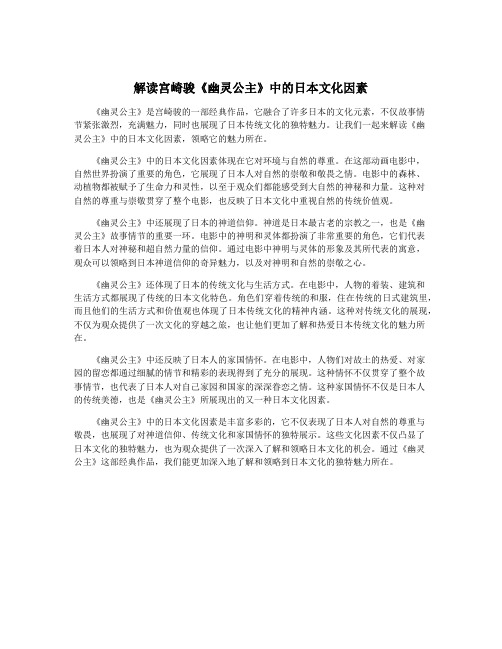
解读宫崎骏《幽灵公主》中的日本文化因素《幽灵公主》是宫崎骏的一部经典作品,它融合了许多日本的文化元素,不仅故事情节紧张激烈,充满魅力,同时也展现了日本传统文化的独特魅力。
让我们一起来解读《幽灵公主》中的日本文化因素,领略它的魅力所在。
《幽灵公主》中的日本文化因素体现在它对环境与自然的尊重。
在这部动画电影中,自然世界扮演了重要的角色,它展现了日本人对自然的崇敬和敬畏之情。
电影中的森林、动植物都被赋予了生命力和灵性,以至于观众们都能感受到大自然的神秘和力量。
这种对自然的尊重与崇敬贯穿了整个电影,也反映了日本文化中重视自然的传统价值观。
《幽灵公主》中还展现了日本的神道信仰。
神道是日本最古老的宗教之一,也是《幽灵公主》故事情节的重要一环。
电影中的神明和灵体都扮演了非常重要的角色,它们代表着日本人对神秘和超自然力量的信仰。
通过电影中神明与灵体的形象及其所代表的寓意,观众可以领略到日本神道信仰的奇异魅力,以及对神明和自然的崇敬之心。
《幽灵公主》还体现了日本的传统文化与生活方式。
在电影中,人物的着装、建筑和生活方式都展现了传统的日本文化特色。
角色们穿着传统的和服,住在传统的日式建筑里,而且他们的生活方式和价值观也体现了日本传统文化的精神内涵。
这种对传统文化的展现,不仅为观众提供了一次文化的穿越之旅,也让他们更加了解和热爱日本传统文化的魅力所在。
《幽灵公主》中还反映了日本人的家国情怀。
在电影中,人物们对故土的热爱、对家园的留恋都通过细腻的情节和精彩的表现得到了充分的展现。
这种情怀不仅贯穿了整个故事情节,也代表了日本人对自己家园和国家的深深眷恋之情。
这种家国情怀不仅是日本人的传统美德,也是《幽灵公主》所展现出的又一种日本文化因素。
《幽灵公主》中的日本文化因素是丰富多彩的,它不仅表现了日本人对自然的尊重与敬畏,也展现了对神道信仰、传统文化和家国情怀的独特展示。
这些文化因素不仅凸显了日本文化的独特魅力,也为观众提供了一次深入了解和领略日本文化的机会。
英语中的日语词

鋤焼〔き〕 (寿喜焼、すきや 寿喜烧(日式牛肉火锅) き) 相撲(すもう) 擂〔り〕身(すりみ) 寿司61(すし) 足袋(たび) 蛸焼〔き〕 (たこやき) 溜り63(たまり) 短歌(たんか) 狸(たぬき) 畳(たたみ) 鉄板焼 〔き〕 (てっぱんやき)
-6-
相扑 鱼浆,蟹香鱼肉棒 寿司 (日本式)短布袜 章鱼烧,章鱼小丸子 溜酱油 短歌64 狸子(皮) 榻榻米 铁板烧
-7-
豆腐 凹间,壁龛66 (神社入口的)牌坊 (日本刀的)护手 1. 坪 2. 穴位,穴道 海啸 乌冬面 浮世绘 卫生筷,一次性筷子 山葵70,山萮 日本陶瓷 烤鸡肉串,日式烧鸡 野寇崽,日本瘪三 大和民族(的一员) 大和绘 浴衣 日本柚子73 财阀 财术 坐禅 禅
zori
草履(ぞうり)
草屐,草鞋,人字拖
級(きゅう) 弓道(きゅうどう) 巻〔き〕物(まきもの) 巻〔き〕鮨(まきずし) 漫画(まんが) みかど(御門、帝) みりん(味醂) 味噌(みそ) 餅(もち) ナシ(梨) 納豆(なっとう)
(柔道等中的)级 弓道 (横幅)卷轴 寿司卷 漫画 天皇 味淋 味噌,日本豆面酱 糯米团,麻糬 梨 纳豆 (系在烟荷包、钱包等绳
野葛,葛藤 日本姑娘 艾绒,干艾 人力车,黄包车,洋车 少量,一点点 酱油 拓麻歌子,电子鸡 短棍术,短棍 天妇罗,天麸罗 大亨,巨头,巨擘 天蚕 圆,日元
-8-
本文列出的仅为一些常见词汇,亦含部分专业用语,但不包括人名、地名等专有名词。另 有一些词语,因仅见诸部分词典,多数词典未加收录,今附于下方,权供参考,汉语释义恕 不写出。详细资料请阅 List of English words of Japanese origin 及日本語から英語への借用。 akebi アケビ basho 場所 burakumin 部落民 dango 団子(だんご) fujoshi 腐女子 gagaku 雅楽 izakaya 居酒屋(いざかや) Kakiemon 柿右衛門 Kakuro カックロ Kawasaki disease 川崎病 keiretsu 系列 kondo 金堂(こんどう、きんどう) konjac コンニャク maruyu マル優 mawashi 回し Moyamoya disease もやもや病 Nisei 二世 Nurikabe ぬりかべ pachinko ぱちんこ raku ware 楽焼(らくやき) reishi 霊芝 sansei 三世 shashin 写真 shokku ショック Tanabata 七夕(たなばた、しちせき) tsutsugamushi disease ツツガムシ病 umami 旨味、旨み utchari 打〔っ〕遣〔り〕 wagyū 和牛 Yayoi 弥生 这里的“变化”是针对依照假名写出的罗马字而言,如将 円(en)写成 yen;但省去长 音 う(u)例外,如将 道場(doujou)写成 dojo。 1 韩国也有所谓的合氣道(합기도) ,英文作 hapkido。 2 A type of Japanese animated film with themes and styles similar to manga comics. “アニメ” 是“アニメーション” (animation)的略称。 3 = Lantern Festival, Festival of the Dead. A Japanese Buddhist festival that takes place in August, when people show respect to the dead. “盆”是“盂蘭盆(うらぼん) ”的略称。 4 和製英語, 是 costume play (コスチューム・プレイ) 的缩略;表演者一般被称为 cosplayer (コスプレイヤー) 。 5 如 He is a 6th dan at judo. 彼は柔道 6 段だ。他柔道 6 段。 6 用海带、狐鲣鱼煮出的高汤,烹饪用。 7 指自创的、不受商业影响的动漫、游戏作品。 8 A room or hall for the practice of martial arts (as judo or karate).(教授柔道、空手道等的)武 术馆。
宫崎骏动漫介绍(英文)

Princess Mononoke(1997)
幽 灵 公 主
1997年宣传语:活下去!
故事发生在日本的室町时代,阿席达卡所在的 部落虾夷族位于日本的东北部。阿席达卡中了 邪神的诅咒,性命难保。为了化解诅咒之谜和 拯救自己,阿席达卡去西方查个明白。珊是被 人类遗弃由狼神养大的狼的女儿。为了保护森 林,幽灵公主只身夜袭达达拉。在敌众我寡的 情况下,幽灵公主形势危急,阿席达卡挺身而 出,并为此中了一枪,危在旦夕。被阿席达卡 带出达达拉城的敢所感动, 由于阿席达卡伤势过重,珊将他带到到山兽神 (麒麟神)的森林希望山兽神救活他。拯救了 森林的阿席达卡最终没能和珊走到一起,珊对 人类破坏森林的罪行仍无法释怀,她选择回到 了林中。
Kiki‘s Delivery Service (1989)
魔女宅急便
1989年宣传语:尽管也曾有消沉的时候,
我还是过得很好
相传魔女家庭少女要成为一个合格魔女, 必须经过社会实践考验。必须选择13 岁这一年中月圆之夜离开自己生活地方, 去陌生地方生活来证明自己能力。13 岁少女琪琪利用自己会飞行本领,在柯 里柯镇面包店打工和送快递。完全没有 工作经验的她,对一切都充满好奇和不 解。她的出现为平静小城带来一场不小 风波。但是她用她的善良和能力帮助了 许多镇上的人,交到许多朋友,同时也 经过许多小波折,最后琪琪终于成为了 一个合格魔女,在新城市里她将用自己 力量去开创自己生活道路。
宫崎骏电影
孩子的眼神,让我相信这个世界上还有 着纯真——宫崎骏
黄海莉
宫崎骏(Miyazaki Hayao,1941年1月5日) 日本著名动画导演、动画 师及漫画家,出生于东京 都文京区。宫崎骏动画作 品大多涉及人类与自然之 间的关系、和平主义及女 权运动,他在日本动画界 占有超重量级的地位,更 在全球动画界具有无可替 代的地位,迪士尼称他为 “动画界的黑泽明”《时 代周刊》评价他为全球最 具影响力的人物。
crossange

crossange《CROSS ANGE十字架战记》是一部由日本动画导演三浦贵博执导的科幻战争动画作品。
该动画以一个崭新的世界为背景,故事发生在一个由女王统治的阴暗帝国,讲述了一个被贱民所轻视的少女安吉利斯·尤基瑟拉(Ange)的传奇故事。
本文将从故事背景,角色塑造,情节发展等方面对《CROSS ANGE十字架战记》进行分析。
首先,我们来了解一下故事背景。
在这个虚构的世界中,人类文明已经高度发展,能以能源粒子「元素」来驱动各种设备。
然而,只有拥有特殊能量「龙启」的可飞行的龙型飞机兵器系列「巨天使」能够抵御从几个世纪前侵袭大陆的巨龙所引发的摧毁性战争。
为了拥有龙化能力,人们会先将婴儿进行龙化基因的检测。
如果检测结果合格,婴儿就能成为一名天使候补生,在紧急时刻能够转变为绝顶强者。
然而,本作中的女主角安吉利斯并不是一个普通的人。
因为她在龙化检测中被检测出是「女神」的候补生,女神是在教导家族里负责治理的威严。
不过,安吉利斯却因此被流放到一个被作为垃圾的地方,逐渐被大家所遗忘。
作为这个虚构世界中最底层的女仆之一,她被无视、羞辱、甚至遭到殴打。
这种无助和恐惧感成为了她对这个世界的全部记忆。
然而,当安吉利斯遇到了名叫塞佳的角色,她的命运开始有了微妙的改变。
角色塑造是《CROSS ANGE十字架战记》的一大特点。
安吉利斯这个角色是一个极富魅力和复杂性的女主角。
她一开始是个被命运所束缚的人,性格坚韧不屈,无论遭遇多少困难和痛苦,她总是找到力量继续前行。
她在成为女王后,她学会了宽容和勇气,并努力为她的同胞们带来和平和幸福。
在她的成长过程中,她还体会到了友情、家庭和爱情的重要性,这使她逐渐蜕变成一个真正的英雄。
此外,该动画还通过各种情节的发展展示了社会中的歧视、权力斗争等现实问题。
从安吉利斯被遗忘的底层生活,到她的流放和抗争,再到她与伙伴们一同面对敌人的战斗,故事中的情节张弛有度,扣人心弦。
作品还涉及到复杂的政治议题和道德问题,通过角色之间的相互作用和发展展现出人性复杂的一面。
我经常看日本动漫英文作文

我经常看日本动漫英文作文英文,I often watch Japanese anime. I find it both entertaining and educational. There are many reasons why I enjoy watching anime. Firstly, the stories are often very creative and imaginative. For example, in the anime "Naruto," the main character, Naruto Uzumaki, is a young ninja who aspires to become the strongest ninja in his village. The story is full of action, adventure, and friendship, which keeps me hooked and wanting to watch more.Secondly, I appreciate the art style of anime. The characters are often drawn with unique and expressive features, and the animation is usually very well done. For instance, in the anime "Spirited Away," the attention to detail in the animation of the spirit world is truly captivating. The vibrant colors and fluid movements make it a visual treat to watch.Another reason I love watching anime is that it allows me to learn about Japanese culture and traditions. Forinstance, in the anime "Your Name," the story incorporates elements of Shinto beliefs and rituals, as well as the beauty of Japan's countryside. It's a great way for me to immerse myself in a different culture and gain a better understanding of it.中文,我经常看日本动漫。
宫崎骏动画电影中的自然人文情怀

《 天空 之城 》 象征人 与 自然和谐 共生 的雷 帕 里 特 城 , 一个 绿草 如茵 、 木茂盛 的理 想 空 就是 树 《 龙猫 》 一开始就展 现 了世外桃 源般的 田园 风 光 , 的远 山 、 白的云朵 、 青青 洁 碧绿 的田野 、 清 澈的小溪 , 一切都 充满 了诗 情画意 《 回忆 的 点 点滴 滴 》 讲述如 诗 的少 女情怀 , 满眼 绿色 在 的乡村 中, 主人公 引领观 众 回首金 色的童年 , 让 久 在凡 尘 中倦 怠 的心 灵获 得片刻 休恐 《 尔 哈 的移动城 堡 》 移动城 堡行 走在群 山之 间, 中, 阿 尔卑 斯山的 白色 雪线, 绿色点缀 的起 伏小路 , 瓦 尔登 湖畔的湖光 山色在 银幕上次第 展现。 这些 取 自欧洲名 胜风光 的动 画美景 , 都表达 了宫崎 骏 向往宁静 生活的 内心 世界 , 一扫观影 者在 也
除了和要 表达 的主题 相扣合 之外 , 现 出其 也体
受到 曰本民族色彩观 的影 响。 在宫崎骏 的动漫电影 中, 色是画面 的主 绿 色调 . ” 为反复 出现 的意 象 。幽灵公 主 》 “ 成 树 《 中 出现 了满山森林 , 郁郁葱 葱的大森 林里水 光 树影相映 还有 夜晚涉水而来 , 满身透着绿 色荧 光的麒麟神 以及 在森林里游 弋的绿色小树精
黧
鍪蚕 鋈堇 誊 攀 量 歪 幕 圣誊 ■●●■●●
湖学传影术I 南新播视学 亚 大闻与艺院 孙
分 青 红皂 白地 疯 狂伤 害 和破 坏 。 了让 灵魂 为 安 息, 须建造好 的神社加 以祭奠 。 幽灵公 必 在《 主 》 猪神被 幻姬 的火 枪所伤 , 弹撕裂 筋骨, 中, 铁 痛楚 无比 , 它的怨气和 诅咒聚集 , 变为 魔祟神 ,
征着 推动人 类近代文 明进程 的工业技术 , 天空 雅. 用石头堆 成的 “ 道神 ” 路旁 祖 因为年长 日久 之城 拉普达 和飞 行石拥 有这样 的矛盾: 面拥 一 浑 身长 满青苔 或 隐或现于 草丛 之 中才会 让行 有 巨大的能量 , 一面又 怕被人利 用而导致世 界 人 觉得亲切 。 如人们在幽静 的村头或呼 啸的 譬 的毁灭。 海 边建 立起作 为神 社象 征的 “ 乌居 ” 坊) ( 牌 , 把 在影 片《 千与千寻 》 中 宫崎骏运用象征 的 林 中高大 的古 木 或海 滨壮 观 的礁 岩 用 “ 注连 手法 . 将河流 化为具体 的形象—— 腐烂神 c风 《 = 绳” 围起 来, 围在 中间 的自然物奉 为神灵 。 将 人 之谷 》 影片 开始 处, 让观 众 目睹 了一个 死 在 就 与神是如此 的贴近 。 亡的村落 。 落 、 村 山谷 、 天空 无~不是一派颓败 宫崎骏 在动画 中塑造 了无数 的精 灵和神 的、 荒凉 的世界 末 日之景 。 更可怕 的是. 人是残 怪 风 之谷 》 的王虫 荷母 能辨善 恶 , 回生 , 起死 疾的 , 是石 化的 ・ 风 之谷 》 肉体 ・ 《 工业文 明和 俨 然 神祗 《 龙猫 》 中的 龙猫 、 巴± 、 灰尘 猫 黑 所谓 的科学 技术 给人类 和 自然带来 的灾难纳 和《 幽灵公主 》 中的魔祟神 、 麒麟 兽 、 野猪神 、 狼 入考察视 野 , 如《 正 天空之 城 》 姆爷爷警示 里波 神、 树精 是 自然袍 《 千与千 寻 》 中来汤屋 洗澡 的那 样 . 石 既能 给人 带 来幸 福 , 给人 飞行 也能 的是 蔬菜神 , 婆是鸟神, 为之清洗污秽 汤婆 千寻 带来灾难 。 这个 道理寓意着人 类为满足 自身无 的是 河神 , 独的无颜 是春 日大社祭经 常出现 孤 止境 的需 求所仰仗 的科技 , 其实也是 一把双刃 的面具神 , 泡在池 子里 的可爱小鸡是 鸡仔 神, 还 剑。 人 与 自然 的对 立 中, 在 自然的 生存法 则和 有 贪 婪的青 蛙神 、 勇敢 的 白龙神 , 连锅 炉爷 就 人类的发展权 利空 间究竟 孰是孰非?影片 《幽 爷 的小煤球也都 有神性 《 尔的移 动城堡 ) 哈 冲 灵公主 》 中阿西达 卡做 出了这样 的回答 : “ 无论 古 老 的城 堡 、 苗 、 草人等 都有 神性 《 火 稻 悬崖 怎样, 们共 生” 让我 , 在这里 , 宫崎骏 回避了 口号 上 的金鱼公主 》 中的海洋之神 、 人鱼 、 大黑鱼等 似 的呼吁 环境保 护, 而是在 富有趣 味的故事 中 也有 奇异的神性 《 魇女宅急便 》 中的黑 猫吉吉 告诫 人们 : 人与 自然 必须共 存共 生 , 只有这 样, 会说人话 。 所有这些 非人类的精怪都表 现 出了 人 与 自然之间的永恒 矛盾 才能随风消散。 神性 , 能不说是神 道“ 这不 万物 有灵 ” 思想 的具 四、 对人性迷失与 回归的深 入探寻 体体现 。 清澈 的河 水 、 丽的村庄 、 美 外表可怕 其实 在 神道 思想 看来 , 于 自 己手 中的对手 , 死 却内心 善 良的神 灵, 让生 活在充 满诱 惑 、 欲 物 如果 不诚 心祭 祀 , 成 为冤魂 。 就会 而一 旦成 为 横流 的环境下的观 众, 了一次心 灵的洗礼 经历 冤魂 野鬼 , 会 时时 出来作 祟 。 人 类伤 害的 就 被 陶醉 在美丽 的自然景致 中从 而 实现 自我反思, 动物 无法消 除巨大的怒 气, 怨恨就化 身诅 那些 找回迷失的 自我。 咒 成 为散播 仇 恨和 诅 咒 的魔祟 神 。 谁若 杀 了 在《 千与 千 寻 》 , 从城 市到 乡村 的路 中在 它 , 负 了难 以化 解 的诅 咒, 现 象也 叫“ 就背 这种 上 , 因为偷 吃 了路 边无人小店 里 的食 物而 父母 生灵 祟人 ” 者 的怨恨 无法 化解 , 和死 者 , 死 生者 触犯 了禁�
日本JANPA

“日出之国”——JAPANIt is composed of over 3,000 islands, the largest of which are Hokkaidō, Honshū, Shikoku, and Kyūshū.Basic Information•Full Name: Japan•中文名称:日本国(简称:日本)•Capital: Tokyo (东京都)•National Flag:Nisshōki (日章旗, "sun flag")•Total Area:377,835 square kilometers•Population : 126 million(estimated in 2013) / 1.26亿•Lanauge: Japanese•Currency: Yen (日圆)(¥,JPY)1人民币元=16.2385日元1日元=0.06158人民币元•National Flower: Sakura(樱花)•Main Religion: Shintoism(神道教)Buddhism(佛教)•Major Political Parties: The Conservative Party(保守政党),The Reform Party(革新政党),中道政党。
•Government Type: Parliamentary constitutional monarchy(议会制君主立宪制)•Current Prime Minister: Shinzo Abe(安倍晋三)•National Anthem:君之代(君が代,Kimigayo)是日本国歌•National Bird : 绿雉(学名:Phasianus versicolor)•National stone:Berg crystal(水晶)•Famous mountain: Mt. Fuji日本国旗:日章旗,亦称太阳旗,呈长方形,长与宽比为3:2(标准国旗长度尺寸)。
crossange
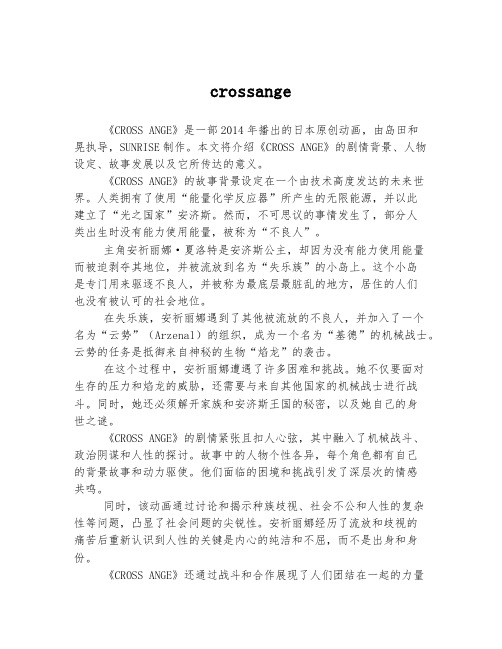
crossange《CROSS ANGE》是一部2014年播出的日本原创动画,由岛田和晃执导,SUNRISE制作。
本文将介绍《CROSS ANGE》的剧情背景、人物设定、故事发展以及它所传达的意义。
《CROSS ANGE》的故事背景设定在一个由技术高度发达的未来世界。
人类拥有了使用“能量化学反应器”所产生的无限能源,并以此建立了“光之国家”安济斯。
然而,不可思议的事情发生了,部分人类出生时没有能力使用能量,被称为“不良人”。
主角安祈丽娜·夏洛特是安济斯公主,却因为没有能力使用能量而被迫剥夺其地位,并被流放到名为“失乐族”的小岛上。
这个小岛是专门用来驱逐不良人,并被称为最底层最脏乱的地方,居住的人们也没有被认可的社会地位。
在失乐族,安祈丽娜遇到了其他被流放的不良人,并加入了一个名为“云势”(Arzenal)的组织,成为一个名为“基德”的机械战士。
云势的任务是抵御来自神秘的生物“焰龙”的袭击。
在这个过程中,安祈丽娜遭遇了许多困难和挑战。
她不仅要面对生存的压力和焰龙的威胁,还需要与来自其他国家的机械战士进行战斗。
同时,她还必须解开家族和安济斯王国的秘密,以及她自己的身世之谜。
《CROSS ANGE》的剧情紧张且扣人心弦,其中融入了机械战斗、政治阴谋和人性的探讨。
故事中的人物个性各异,每个角色都有自己的背景故事和动力驱使。
他们面临的困境和挑战引发了深层次的情感共鸣。
同时,该动画通过讨论和揭示种族歧视、社会不公和人性的复杂性等问题,凸显了社会问题的尖锐性。
安祈丽娜经历了流放和歧视的痛苦后重新认识到人性的关键是内心的纯洁和不屈,而不是出身和身份。
《CROSS ANGE》还通过战斗和合作展现了人们团结在一起的力量和重要性。
团队中的每个成员都有各自的特长和贡献,只有通过彼此的配合和信任,他们才能在艰难险恶的环境中生存下来。
总之,《CROSS ANGE》以其紧凑的剧情、深刻的人物设定和对社会问题的思考,成为了一部令人难以忘怀的优秀动画作品。
日本动漫英语简介
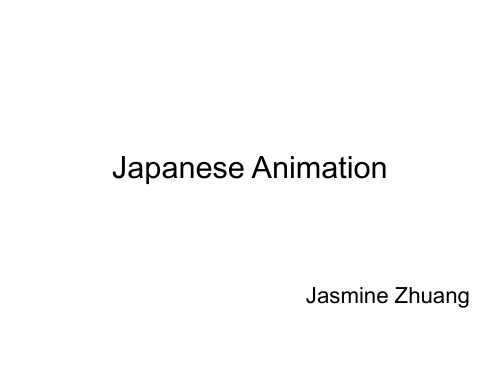
Jasmine Zhuang
Three parts:
• 1.The developing history of Japanese animation
• 2.Famous animation producer--Miyazaki Hayao
• 3.Famous animations
THANK YOU!
Crayon Shin-chan
• Crayon Shin-chan is a Japanese manga and anime series written by Yoshito Usui. The series follows the antics of five-year-old Shinnosuke Nohara and his parents, neighbors, friends, dog and many others.
The end
Doraemon(2007-)
• Doraemon is adapted from the famous Japanese cartoon story "more la A dream". Doraemon is a robot cat from the future world, with its mysterious treasure bag and all sorts of wonderful props help da Xiong to solve all kinds of difficulties.
• "Detective Conan" is a detective mystery manga created by Goushou Aoyama in 1994. The story is about a 17-year-old genius detective named Shinichi Kudou who gets poisoned by a mysterious underground crime organization and shrinks into his 7-year-old body. He continues to try and find a cure to un-shrink his body, solving various mystery cases along the way.
日本动漫文化 英文~(新)

1.Origin 2.The history of anime 3.Popular reasons 4.Characteristic and type 5.Famous author
1917-1945:the birth of Japanese anime
Momotarô: Umi no shinpei 桃太郎海上神兵
1946-1973:Explore period
手冢治虫(1928-1989) Astro Boy
1974-1989:Mature period
藤子· F· 不二雄(1933年-1996年) DORAEMON
The Japanese anime, is called the Japanese cartoon and Japanese Caricature.
Japan is the world's largest animation powerful country. Japanese started from 1917,it has 96 years for now.
Popular reasons
Japanese anime have a strong targeted. Japanese cartoon is classified according to the age and sex of the readers
classificat-blood(热血)
Characteristic and type
英文介绍日本动漫

四代风影 我爱罗
晓 ATASUKI
• the group is called the atasuki group. it contains 9 people.
melody of hope
• every fans of NARUTO hope that one day, they will become friends like before.
羁绊
Rokudou mukuro 六道骸
•Got the cloud ring •拥有彭格列雾属性指环
Hibari kyoya 云雀恭弥
•Got the fog-ring •拥有彭格列云指环
Sawada Tsunayoshi
沢田纲吉
•Got Ozora ring •拥有彭格列太空属性指环 • 彭格列boss
Yondaime Hokage
四代火影
• the main plot of NARUTO
• In Naruto the official story started 12 years ago, one is called "9 Yaohu"(九尾妖狐) huge monster attack on Konoha ninja village. It is a legend would be a landslide tsunami wave tail. Huo Ying was the fourth generation of their own lives to seal the nine Yaohu newborn children (both four generations of the Watergate affair Huoying their children) Naruto Uzumaki people.
神话故事日本神话中的神道与神社
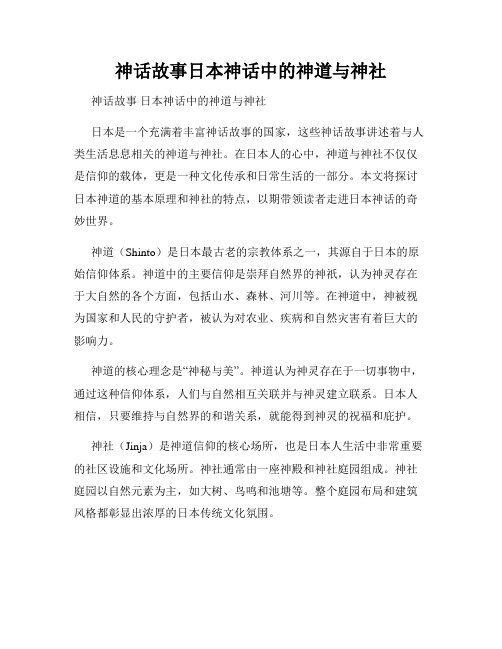
神话故事日本神话中的神道与神社神话故事日本神话中的神道与神社日本是一个充满着丰富神话故事的国家,这些神话故事讲述着与人类生活息息相关的神道与神社。
在日本人的心中,神道与神社不仅仅是信仰的载体,更是一种文化传承和日常生活的一部分。
本文将探讨日本神道的基本原理和神社的特点,以期带领读者走进日本神话的奇妙世界。
神道(Shinto)是日本最古老的宗教体系之一,其源自于日本的原始信仰体系。
神道中的主要信仰是崇拜自然界的神祇,认为神灵存在于大自然的各个方面,包括山水、森林、河川等。
在神道中,神被视为国家和人民的守护者,被认为对农业、疾病和自然灾害有着巨大的影响力。
神道的核心理念是“神秘与美”。
神道认为神灵存在于一切事物中,通过这种信仰体系,人们与自然相互关联并与神灵建立联系。
日本人相信,只要维持与自然界的和谐关系,就能得到神灵的祝福和庇护。
神社(Jinja)是神道信仰的核心场所,也是日本人生活中非常重要的社区设施和文化场所。
神社通常由一座神殿和神社庭园组成。
神社庭园以自然元素为主,如大树、鸟鸣和池塘等。
整个庭园布局和建筑风格都彰显出浓厚的日本传统文化氛围。
神社的建筑风格以悬垂式屋顶、红色色调和木制结构为特点。
一座神社通常有多个神像,供人们祭拜和膜拜。
神社庭园也被用作举办各种神道仪式和庆典活动的场所。
日本的神社还承载着许多文化传统和庆祝活动。
其中,最著名的庆典是新年祭典。
每年元旦,成千上万的日本人会参观神社,祈求新年的好运和健康。
此外,婚礼、成人礼和孩子的第一次参拜等重要场合也常在神社举行。
神社在日本文化中具有重要的意义。
人们以神社为依托,感受到神性的存在,并寻求神灵的保佑。
此外,神社还承担着社区聚会和人们休闲的功能,成为日本人日常生活的重要组成部分。
总之,神道与神社是日本神话故事中的重要元素。
通过神道的崇拜和神社的存在,人们与神灵建立了密切的关系,通过维持与自然界的和谐相处,希望获得神灵的祝福和守护。
神社作为神道信仰的核心场所,不仅承载着人们的宗教情感,也是日本文化传承和日常生活的一部分。
推荐八部少儿不宜的日本动画佳作,高分高能

动画华丽、奇诡,充满哲学意味,神秘的祭祀仪式瑰丽无比,引 人入胜。
《皇家国教骑士团》 (2001)
Байду номын сангаас
平野耕太同名漫画改编,吸血鬼题材。皇家国教骑士团是一个组 织,组织旨在消灭反基督怪物,维护基督教。西洛斯·维多利亚遭到袭 击,奄奄一息,吸血鬼杀手阿尔卡特出现,铲除食尸鬼,并将西洛斯 变成了吸血鬼的一员。
浮世绘的画风,很唯美,喜欢这个画风的话看这部动画是一种享 受。
《魍魉之匣》 (2008)
唯美的少女动画画风,却在讲述一个与画风截然不同的故事。 作为一部悬疑动画,节奏缓慢,但缓慢中抽丝剥茧,步步揭开神 秘的面纱。一起站台跌落事件牵扯越来越多,关注此事的几个年轻人
在森林中发现古怪建筑物,如巨大的匣子,一切谜底就要揭开…… 《红辣椒》(2006)
这部作品根据士郎正宗的漫画改编,主题聚焦于人类进化的方向, 在信息时代里,生命如何进化?站在生命进化树顶端的人类未来会出 现何种生命?押井守在 1995 年给出了大胆的猜测。
当草薙素子和傀儡师融合之后,这个大胆的设定惊爆眼球。在 《无罪》中,草薙素子才以我们完全想不到的方式登场,巴特依旧为 她披上了外套。
《兽兵卫忍风帖》(1993)
川尻善昭,以其暴力美学闻名,华丽的动作设计,感人的情节加 上奇诡的设定,让人看得眼花缭乱。最具代表性的作品便是《兽兵卫 忍风帖》《妖兽都市》和《吸血鬼猎人 D》。尤其是《兽兵卫忍风 帖》,奠定了其在日本动画界的地位。
故事发生在德川家康统一之后,望月番附近的一个村落村人全部 死光,甲贺组众忍者前往该村调查,结果除了女忍者阳炎之外全部领 便当。主角意外卷入其中,围绕着这个案子,一场巨大的阴谋逐渐展 开……
日本动画中的妖怪形象研究
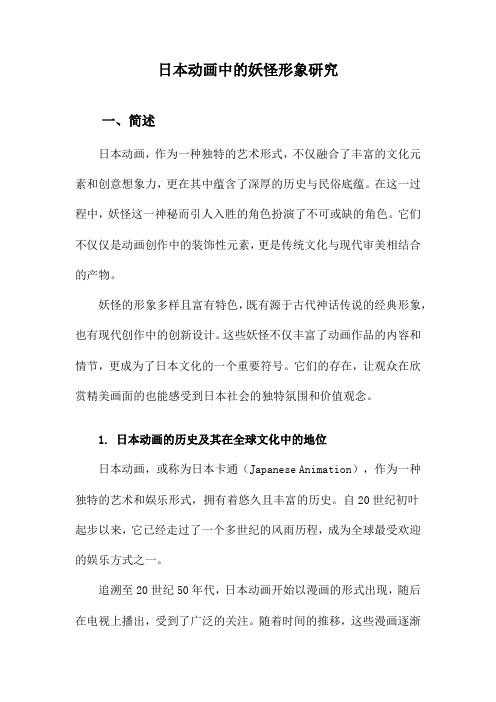
日本动画中的妖怪形象研究一、简述日本动画,作为一种独特的艺术形式,不仅融合了丰富的文化元素和创意想象力,更在其中蕴含了深厚的历史与民俗底蕴。
在这一过程中,妖怪这一神秘而引人入胜的角色扮演了不可或缺的角色。
它们不仅仅是动画创作中的装饰性元素,更是传统文化与现代审美相结合的产物。
妖怪的形象多样且富有特色,既有源于古代神话传说的经典形象,也有现代创作中的创新设计。
这些妖怪不仅丰富了动画作品的内容和情节,更成为了日本文化的一个重要符号。
它们的存在,让观众在欣赏精美画面的也能感受到日本社会的独特氛围和价值观念。
1. 日本动画的历史及其在全球文化中的地位日本动画,或称为日本卡通(Japanese Animation),作为一种独特的艺术和娱乐形式,拥有着悠久且丰富的历史。
自20世纪初叶起步以来,它已经走过了一个多世纪的风雨历程,成为全球最受欢迎的娱乐方式之一。
追溯至20世纪50年代,日本动画开始以漫画的形式出现,随后在电视上播出,受到了广泛的关注。
随着时间的推移,这些漫画逐渐被改编成电影和电视剧,形成了我们现在所熟知的动画形式。
到了70年代,随着《铁臂阿童木》等作品的问世,日本动画开始在国际上崭露头角,吸引了众多粉丝。
进入80年代,随着《超时空要塞》和《鲁邦三世》等作品的出现,日本动画的影响力进一步扩大。
这些作品不仅在日本国内广受欢迎,也在国际上引起了轰动。
这一时期的动画也开始尝试更多的题材和风格,为后来的多元化发展奠定了基础。
进入21世纪后,日本动画的发展更是如日中天。
从《千与千寻》到《龙猫》,再到《鬼灭之刃》和《你的名字》,这些作品不仅在国内屡获殊荣,也在国际上赢得了无数奖项和赞誉。
它们不仅展示了日本动画在艺术和技术上的高超水准,也向世界传递了日本的文化特色和价值观念。
日本动画已经成为全球文化的重要组成部分,它的影响力和受欢迎程度远远超出了动画本身。
从《攻壳机动队》到《新世纪福音战士》,再到《鬼灭之刃》和《你的名字》,这些作品已经成为了全球观众的共同语言和文化符号。
千与千寻的梗概作文400字
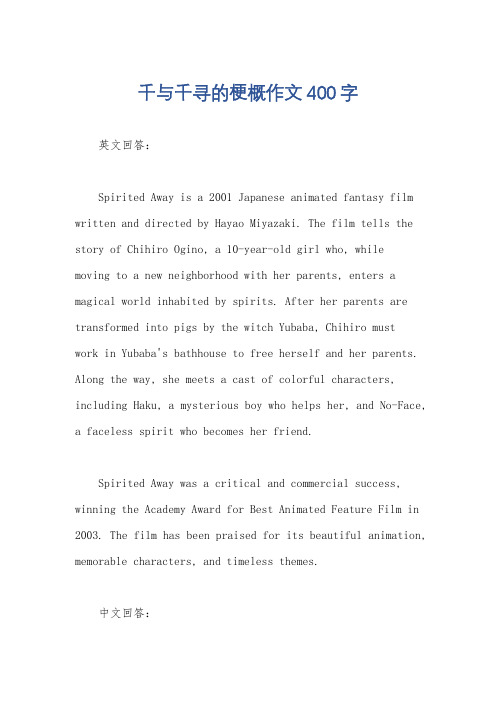
千与千寻的梗概作文400字英文回答:Spirited Away is a 2001 Japanese animated fantasy film written and directed by Hayao Miyazaki. The film tells the story of Chihiro Ogino, a 10-year-old girl who, while moving to a new neighborhood with her parents, enters a magical world inhabited by spirits. After her parents are transformed into pigs by the witch Yubaba, Chihiro mustwork in Yubaba's bathhouse to free herself and her parents. Along the way, she meets a cast of colorful characters, including Haku, a mysterious boy who helps her, and No-Face, a faceless spirit who becomes her friend.Spirited Away was a critical and commercial success, winning the Academy Award for Best Animated Feature Film in 2003. The film has been praised for its beautiful animation, memorable characters, and timeless themes.中文回答:《千与千寻》是一部2001年由宫崎骏执导编剧的日本动画奇幻电影。
日本漫画【英文】
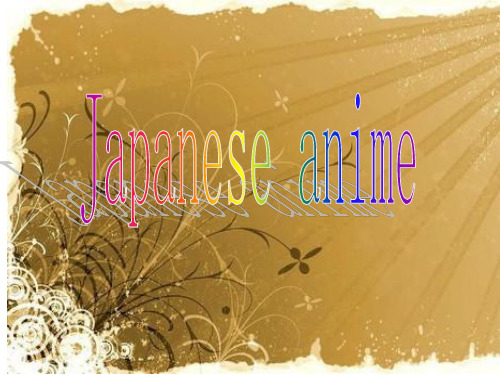
Don’t you still remember all of thes
The history of Japanese anime
1917-1945:the birth of Japanese anime 1946-1973:Explore period 1974-1989:Mature period 1990- now:Twenty-first-century period
Happiness really has nothing to do with love.
t o g e t h e r f
பைடு நூலகம்
The other side of the cloud, the agreed place
,
5.Normal life 《K-ON!》
6.Detective《Detective Conan 》
7.Fantasy 《fairy tail》
I’ll introduce you some cartoons I ever saw recently
Spirited Away
But between us even sent one thousand text messages, Between the heart and the heart but one centimeter didn't close
Simply live, grief everywhere accumulation
a chain of short stories about their distance
T w o p Two people together for a long time, just like the left hand and the right hand, e Even if no longer love will choose to spend, o Because give up so many years of time takes a lot of courage. p l Maybe life will appear to the people you love, but that it is passing through, e You will still hold your left hand or right hand always go on,
有一个日本动画片,里面有一匹马叫X的那个动画片名字是什么?
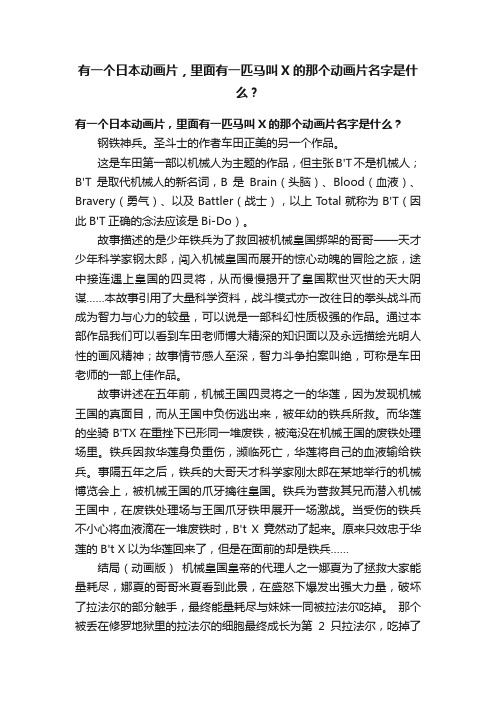
有一个日本动画片,里面有一匹马叫X的那个动画片名字是什么?有一个日本动画片,里面有一匹马叫X的那个动画片名字是什么?钢铁神兵。
圣斗士的作者车田正美的另一个作品。
这是车田第一部以机械人为主题的作品,但主张B'T不是机械人;B'T是取代机械人的新名词,B是Brain(头脑)、Blood(血液)、Bravery(勇气)、以及Battler(战士),以上T otal就称为B'T(因此B'T正确的念法应该是Bi-Do)。
故事描述的是少年铁兵为了救回被机械皇国绑架的哥哥——天才少年科学家钢太郎,闯入机械皇国而展开的惊心动魄的冒险之旅,途中接连遇上皇国的四灵将,从而慢慢揭开了皇国欺世灭世的天大阴谋……本故事引用了大量科学资料,战斗模式亦一改往日的拳头战斗而成为智力与心力的较量,可以说是一部科幻性质极强的作品。
通过本部作品我们可以看到车田老师博大精深的知识面以及永远描绘光明人性的画风精神;故事情节感人至深,智力斗争拍案叫绝,可称是车田老师的一部上佳作品。
故事讲述在五年前,机械王国四灵将之一的华莲,因为发现机械王国的真面目,而从王国中负伤逃出来,被年幼的铁兵所救。
而华莲的坐骑B'TX在重挫下已形同一堆废铁,被淹没在机械王国的废铁处理场里。
铁兵因救华莲身负重伤,濒临死亡,华莲将自己的血液输给铁兵。
事隔五年之后,铁兵的大哥天才科学家刚太郎在某地举行的机械博览会上,被机械王国的爪牙擒往皇国。
铁兵为营救其兄而潜入机械王国中,在废铁处理场与王国爪牙铁甲展开一场激战。
当受伤的铁兵不小心将血液滴在一堆废铁时,B't X竟然动了起来。
原来只效忠于华莲的B't X以为华莲回来了,但是在面前的却是铁兵……结局(动画版)机械皇国皇帝的代理人之一娜夏为了拯救大家能量耗尽,娜夏的哥哥米夏看到此景,在盛怒下爆发出强大力量,破坏了拉法尔的部分触手,最终能量耗尽与妹妹一同被拉法尔吃掉。
那个被丢在修罗地狱里的拉法尔的细胞最终成长为第2只拉法尔,吃掉了正在破坏机械王国的拉法尔,破坏了整个机械王国,脱掉无用的碎片,并试图与机械王国保存在系统里的那个建立机械王国的皇帝的意识相结合。
- 1、下载文档前请自行甄别文档内容的完整性,平台不提供额外的编辑、内容补充、找答案等附加服务。
- 2、"仅部分预览"的文档,不可在线预览部分如存在完整性等问题,可反馈申请退款(可完整预览的文档不适用该条件!)。
- 3、如文档侵犯您的权益,请联系客服反馈,我们会尽快为您处理(人工客服工作时间:9:00-18:30)。
The Question: What is at root of the apparent affinity Japanese animation has for themes of technology, science, and communication between human and non-human forms of existence?
Further, why is animation so popular as a form of film production in Japan?
A corollary to this is, what can the answers to these questions allow Japanese animation to bring to the Western m?
Kôkaku kidôtai (Ghost in the Shell), Oshii Mamoru, 1995
Kôkaku kidôtai’s Cyborg Police Officer, Major Kusanagi
Constructing Kôkaku kidôtai’s Post-human Cyborg Body
• Humans are but one integral part of an information-processing mechanism which incorporates a vast technological network
• Human agency, identity, and subjectivity are distributed and do not reside in the individual: the individual is but one facet of the processes themselves which collectively become “agency,” “identity,” and “subjectivity.”
Constructing Kôkaku kidôtai’s Post-human Cyborg Body
Human/Computer Interface, Information Ports
Human/Computer Interface, Information Ports in Use
• Posthumanism: a way of situating human beings in a mechanised, technologised, nonhuman world
• An attitude which sees human beings as always already intimately coupled with technology • Human beings have always been dependent upon technology for survival, prosperity, and for self-definition
My Contentions:
• Aspects of Japanese philosophy and spirituality, growing from Shinto and its attitudes towards the self, the community, and the natural and spirit worlds, have influenced the popularity of animated (science fiction) films in Japan.
• Japanese animated science fiction intersects with the posthuman debate by accepting the possibility of intelligent, sensitive, non-human forms of existence.
• Kôkaku kidôtai by Oshii Mamoru and the works of Miyazaki Hayao among other animators signal themselves as resisting the anthropocentrism of much human thought, seeing instead consciousness and identity as diffuse things created and shared across multiple and diverse forms of existence.
• By overlooking the ways in which non-Western traditions have conceived of the site of consciousness, posthumanism has effectively cut itself off from a fully articulated alternative vision of cognitive existence.
• Japanese philosophical and spiritual influences can contribute to this emerging, „western‟ attitude toward technology and can allow it to overcome its inherent anthropocentrism
